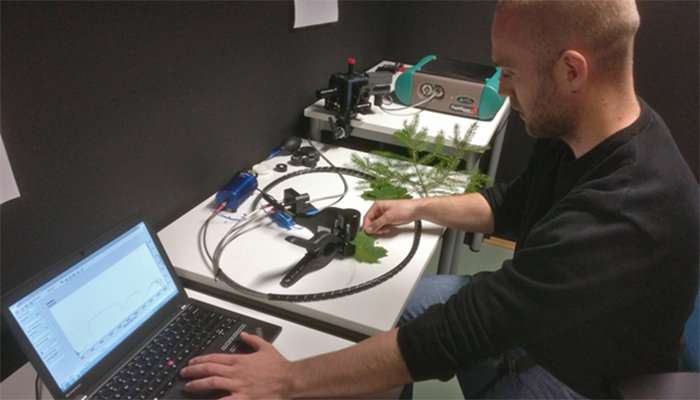Spectral library reveals how boreal trees reflect solar radiation

The number of Earth observation satellites monitoring the environment is growing fast. New satellites are capable of distinguishing increasingly narrow bands of wavelengths and making increasingly frequent observations of forests globally. This opens up new opportunities in monitoring the state of forests and any changes in it.
However, measurements on the capability of different types of trees or plants to reflect solar radiation are required from the Earth's surface as reference material to support the interpretations. Reference material can partly be replaced by physical models for which information on the optical properties of the basic components, leaves and needles, is needed. The researchers of Aalto University's spectral laboratory have now compiled an internationally significant spectral library on the optical properties of the tree species in the boreal (northern) coniferous forests.
"We measured a total of more than 1 000 spectra from needle and leaf samples from arboretums and botanical gardens in the Helsinki region. We managed to get a total of 25 tree species to the spectral library. Many commercially important species from both North America and Eurasia are included, such as the Siberian larch and the black spruce and the white spruce, which are both common in Canada," explains postdoctoral researcher Aarne Hovi.
Trees that reflect more have cooling effects
The researchers showed that the spectral differences between different tree species are the greatest at the end of the shortwave-infrared region, the range of wavelengths that are longer than those visible to the human eye. The result benefits studies aimed at identifying different tree species from remote sensing material, as some of the current satellites are already capable of measuring the end of the shortwave-infrared region.
In addition to the interpretation of satellite material, the measured spectra can be used in the assessment of effects of forests on climate. For example, very little material has until now been available for modelling the forest albedo. Albedo means proportion of solar radiation reflected by the Earth's surface back to space. The new spectral library makes it possible to examine the role of different tree species in the mitigation or acceleration of climate change. What this means in practice is that trees that are the most reflective could be favoured to increase the cooling effects on climate.
"In the spectral laboratory, we are currently developing methods for increasing the accuracy of spectral measurements and speeding them up. This enables, for example, the monitoring the effects of different environmental factors on plants' growth or the health of plants from space," says Aarne Hovi.
"The entire material can also be accessed openly, which increases the possibilities to use it in the development of interpretation methods for satellite images."
More information: Aarne Hovi et al. A spectral analysis of 25 boreal tree species, Silva Fennica (2017). DOI: 10.14214/sf.7753
Provided by Aalto University





















